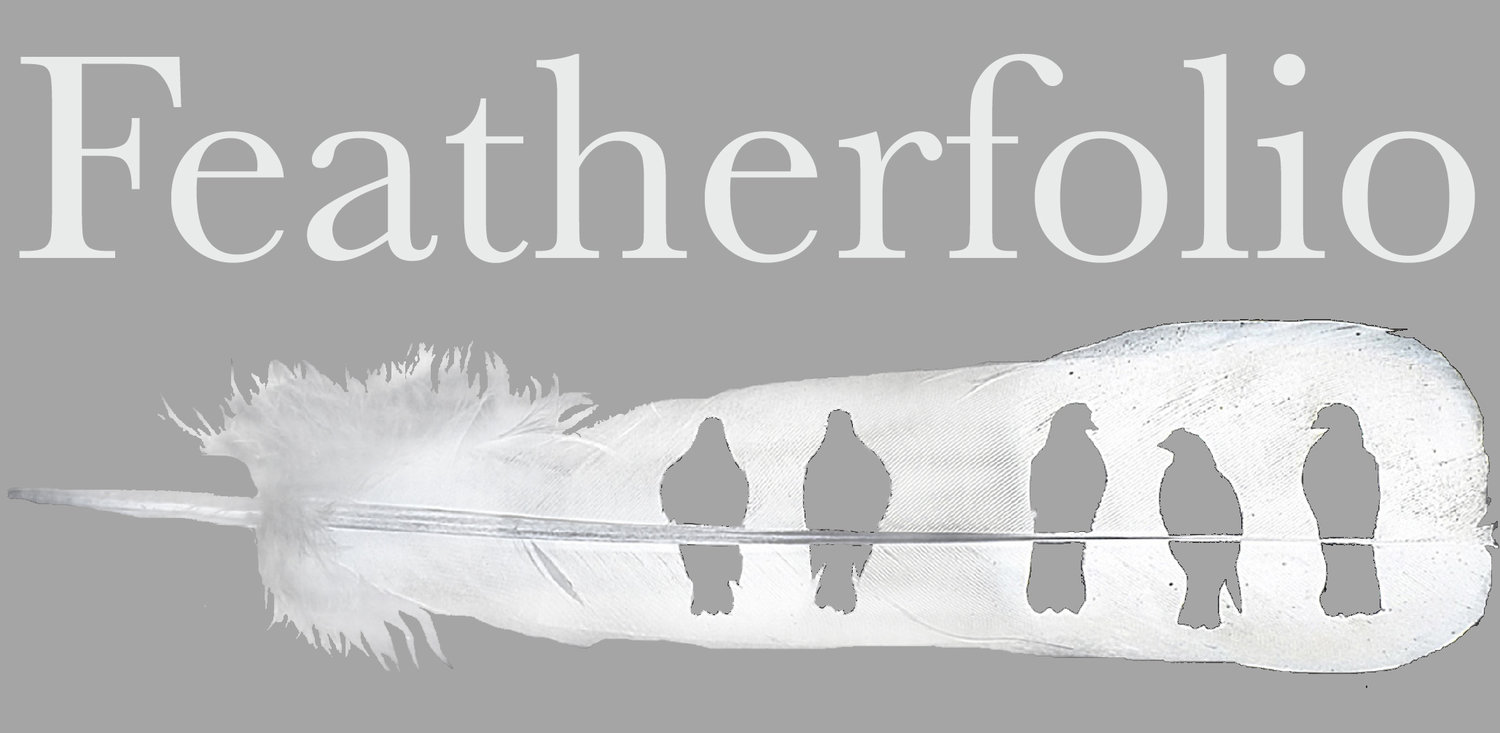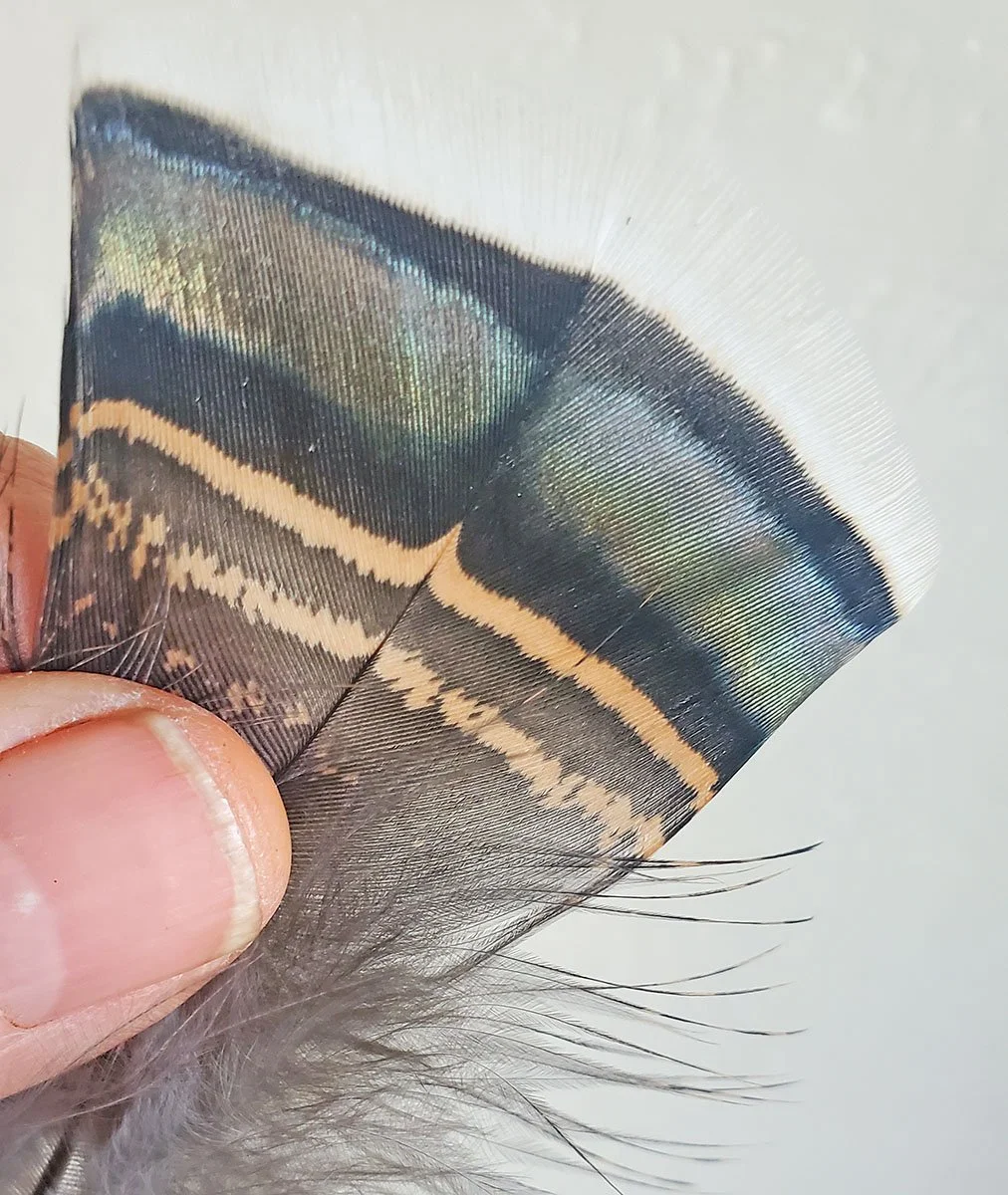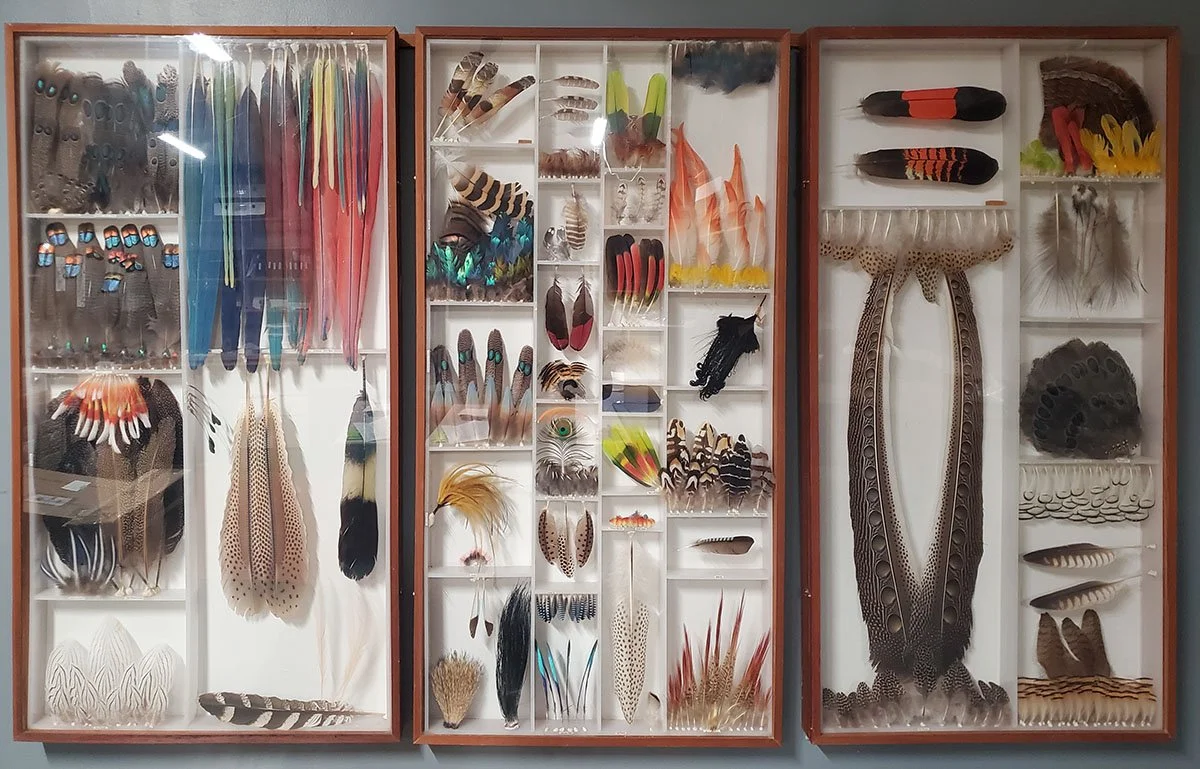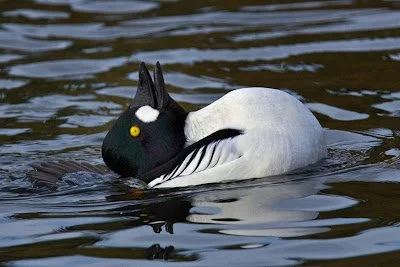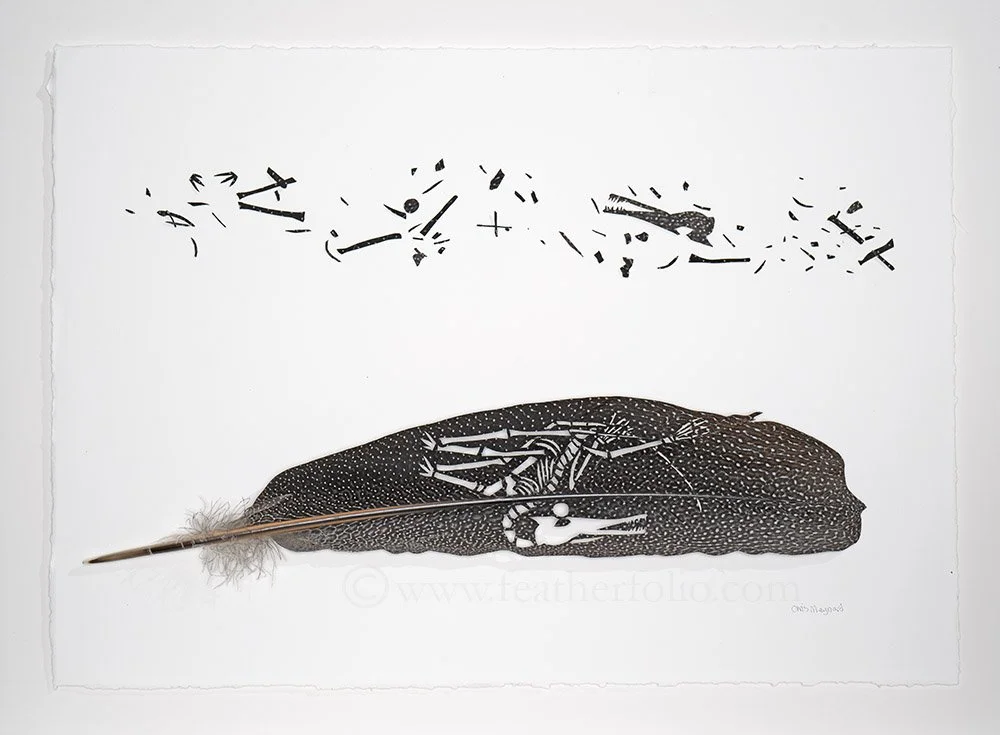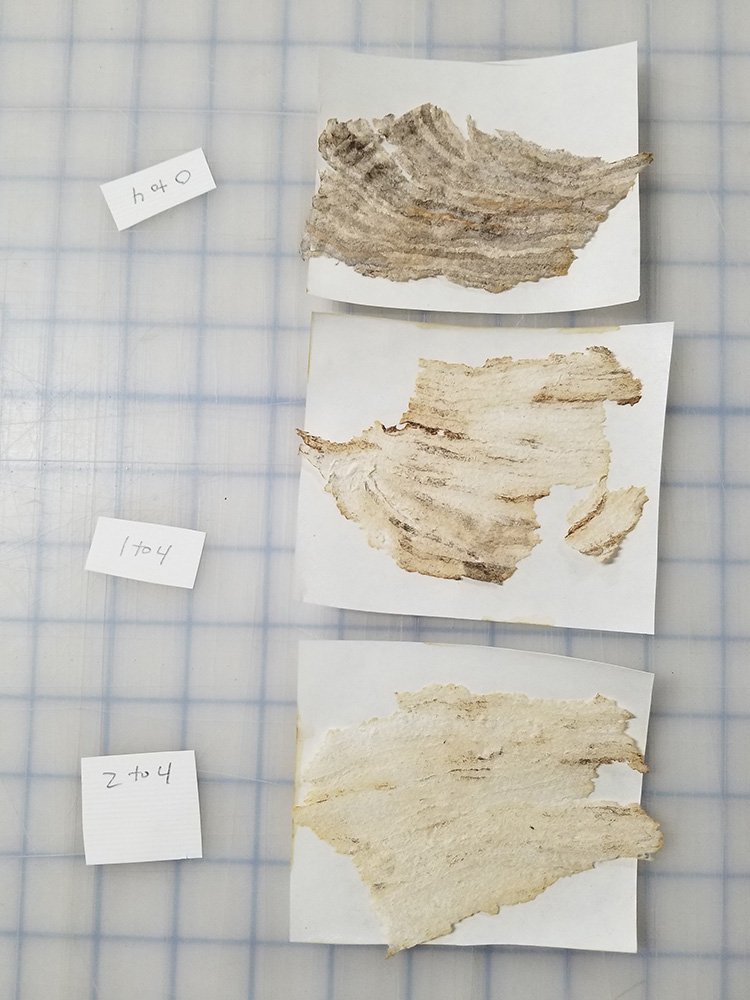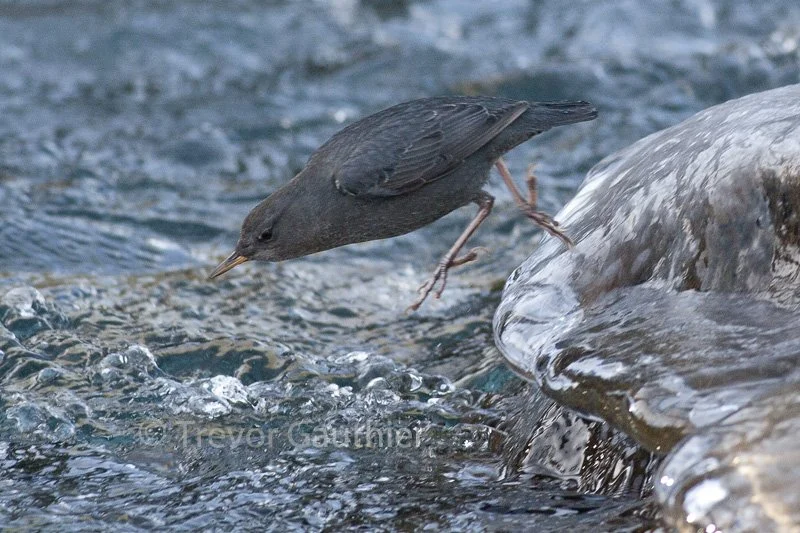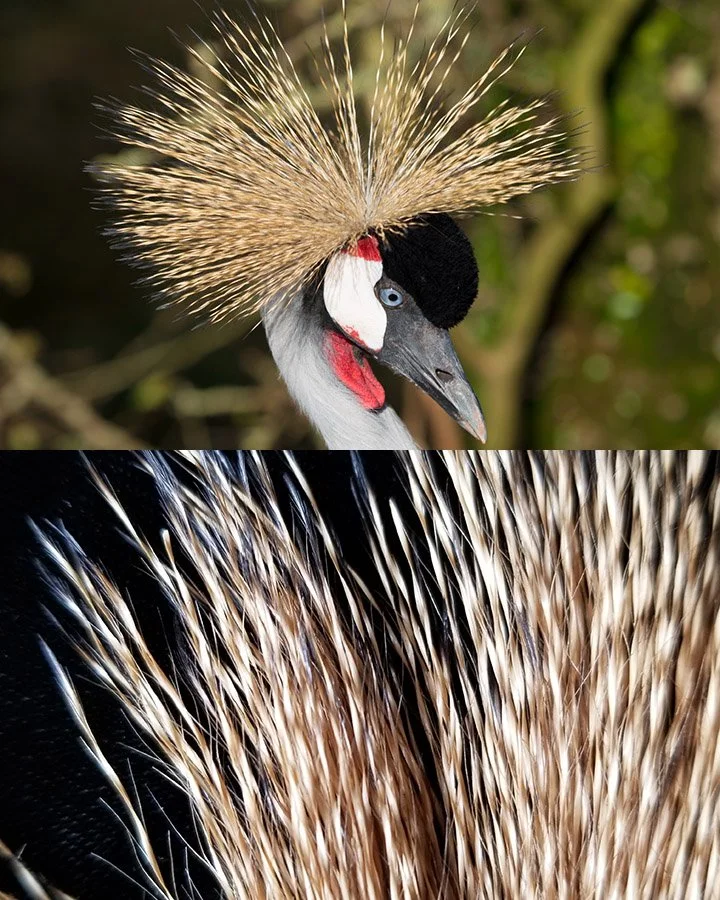Feather shafts look kind of like these pine needles where they attach. Both feather and these pine needles move similarly. A biologist friend told me that the name of the pine needle connection is called a fascicular bundle. For a feather it is called the follicle sheath. It is where on a flight feather the skin that goes up the feather shaft like a sock on your leg and similar to the brown part where the pine needles attach.
Thank You Mister Turkey for Your Meat and Your Feathers /
I use naturally shed feathers in most of my art, except for turkeys. I usually go to a friend’s little farm to get a turkey for the holidays. This time, she gave me her free-roaming two-year-old male whose feathers were in great beautiful shape. He was a heritage turkey which means he was smaller (14 pounds dressed) and more flavorful than ones selected and modified for quick growth that you get in the supermarket: the big broad-breasted white butterballs.
I tried raising a couple of those one year and became revolted at their quick growth because, if I did not kill and butcher them in 4 months, they literally would have grown too fat to walk.
Missing for 20 years /
These three boxes full of feathers languished upstairs in my large barn for 20 years, pretty much forgotten. I rediscovered them last week as I was reorganizing stuff in the barn for a building project. They now hang by the entry to my studio, cleaned up and also reorganized. The feathers, 25 years ago when I assembled the boxes, were carefully selected to be legal to have. Some of them are from exotic pheasants that I had raised and some from aviaries and zoos.
How to see /
We usually see what we think something should look like instead of really seeing what it is. Like this rabbit. Oh, I mean this duck.
Beginning drawing class students often realise this when their first sketches turn out poorly. This is because they are drawing what they think something should look like, from past experience. When they really look at the the lines and shadows and spaces of the object in front of them, their drawings improve dramatically.
This is a good lesson for life: like really try to listen rather than pre-think what a person is saying. Like setting aside assumptions, notions, and prejudices and instead look, listen, and be with a person, a cloud, a tree, or anything. It makes for a stronger presence.
How to Identify a Bird by Its Sound and Song /
Identifying what bird is making that sound is easy. Use the phone app, MERLIN offered for free from the Cornell Lab of Ornithology. Here is a blurb from their website:
“Sound ID unlocks a whole new way of enjoying nature that produces not just one magical moment but many,” said Jessie Barry, program manager of the Macaulay Library at the Cornell Lab. “It really does feel like magic when you match a mystery sound with the name of the bird making it.”
Merlin makes it easy to identify birds as they’re singing. Simply hold up your smart phone, tap the Sound ID button, and Merlin shows you the name of each bird detected in real time, along with a photo to help you clinch the ID.
I tend to focus on my sense of sight. This app encourages me to open to the world of sound.
How to Fix A Chewed Feather Shaft /
Parrots sometimes chew their feathers. When they shed them, the shafts are broken and ratty looking. Here, I cut the bottom hollow shaft of a turkey tail feather and simply pushed it over the parrot feather’s chewed shaft. A tiny dab of glue can hold it in place.
Vacheron Constantin: A Large Installation in NYC /
David Stark Design asked me to create a 21 foot high installation at the Swiss watchmaker’s store in New York City on 57th Street. So I did, working with a great team of people. I had to choose the largest of feathers to work with: The Great Argus Pheasant’s and remaining uncut are macaw tail feathers making a circle reminiscent of a sundial. This will be up through November 2022. Stop in!
I thought that the work would proceed promptly and on time. Well, we finished on time but getting there included last minute changes along the way but in the end, I am happy with it and everyone else is too.
Swallow Bug Koru /
Swallow Koru, 28 x 28 inches
A koru is a Maori name for an unfurling, a sort of spiraling. For me, watching swallows chasing and catching bugs feels deliciously abundant, joyful, and kinesthetic. Life is born to move and dance. Like the delight of watching a fern’s spiraling unfurling.
These two swallows in the center of the feather tell a story about the abundance of insects they eat. They fly around to catch about this many or more bugs every hour.
The mechanics of flight of most insects is different from the mechanics of birds flight. I always imagined that because insects are so small, the air might feel like how moving through water feels to us. Then I can imagine that flight would be an easy thing: just move your arms or whatever you have and you will swim. However, insects employ a completely different kind of muscle movement than birds. The bugs flap their wings very fast and do not use the same aerodynamics that we associate with birds and airplanes.
For any of you science folks, I found this an interesting article about what we have learned so far about how insects fly. https://www.cell.com/current-biology/fulltext/S0960-9822(06)01420-5#relatedArticles. I guess part of the lesson in this article is that even though we think we are smart and know everything, we are just starting to to understand a part of what nature designed (insect flight) 350 million years ago.
Time /
We capture time in our timepieces, watches and clocks. But do we really capture it? Or by naming time in seconds and hours mostly just help us make appointments and feel like we have a secure reference point to deal with the vastness of existence?
I love to go to museums like the American Museum of Natural History to walk through their articulated fossil exhibits of big extinct mammals and dinosaurs. The abundance of creatures that come and go somehow gives me a sense of everything being alright in the world. Sure, our influence on the earth, like being responsible for the disappearance of countless creatures feels horrendous. But seeing how fruitful life is over time through the museum displays reminds me that life is prolific, wondrous, and will endure. And that we are just momentarily here as this weird-looking big-headed creature.
Fossil No. 5147 at the museum is a bird-sized juvenile Pterodactylus, a flying creature before the existence of feathered birds as we know them. But it is likely that Pterosaurs had something like feathers possibly even as long as 200 million years ago. I find it amazing that scientists can come up with so many facts and hypotheses based on old bones.
https://phys.org/news/2020-11-mystery-feather-fluffy-pterosaurs-reignited.html
Shed a Feather or Two /
Laurie Brice, Osprey losing a primary feather mid flight.
It is getting to be that time of year around here when the nestlings have left and the birds are growing new feathers which are pushing out the old ones. You might imagine that when a bird loses one of its main flight feathers, that flying becomes a little more difficult. The birds have different strategies about this that enables them to continue to fly relatively well. Most birds, when they shed a major wing or tail feather, will shed one from the exact opposite side, sometimes almost simultaneously and usually at least within a few days. Then they aren’t lopsided in flight. New feathers grow in at least half-way before the next set of two feathers are shed. This way, a bird can continue to get food, escape from predators, and I like to think, enjoy playing around with their amazing ability of flight.
A Diving Loon, Depth, and Water Color /
Diving Loon
A Loon can dive a few hundred feet below the water surface kicking its paddle feet. A Common Loon is black and white to our eyes. If it were blue, these colors would be seen a hundred feet down when all the other colors would have faded to black. That’s what colors do underwater, they get absorbed. Red turns to black 20 feet down but blues turn to black a lot farther below.
I like to use feathers of the species I am carving but mostly this is not possible for several reasons. Either the feathers are too small or they are not legal to use. For this piece, I still used a water bird’s feathers, although they are from a mallard, a duck.
Air Swimming /
Keeping your arms straight, hands open, swing them fast around and around. Feel the air? For a bird, the thickness and palpability of the air must be a little bit like water feels to us when we swim. Birds need to feel the air currents going past the tips of their wing feathers to be able to respond to the needs of flight. Their long flight feathers act as levers, transmitting the sensation of air pressure to the nerves in the birds' bodies at the bases of their feathers.
How to use wasp paper to make your own /
Wasp paper, bleached
Wasps make paper out of chewed up wood mixed with their saliva. They fly back to their under-construction nest and carefully spit out the saliva/chewed wood pulp in long bands somewhat like caulk coming out of a caulk-gun but instead it is out of their mouths. They use varying convenient sources for their wood which often makes the pulp they bring back differ in color, usually greys and browns. Sometimes they find a white wood source or even bright colors like red if they decide to chew on something like construction paper (which is made of wood pulp and dye).
I have used wasp paper nests as backgrounds to a few of my cut feather shadow-boxes. I carefully unlayer a wasp nest, iron the individual layers, and use a brush and diluted acrylic matte gel to paste the pieces of wasp paper to a heavy cotton watercolor paper.
The final paper has a dark stormy feeling but it is often darker than I want for my feather cutouts.
I just figured out how to lighten the wasp paper with bleach and not have it fall apart. First, I experimented with different nest and was surprised that each nest and pulp source bleached differently. For some, the darker brown bands of chewed wood/spit did not bleach at all while surrounding bands of greyer material did. The bleaching works very quickly so I didn’t vary the soak time, just dipped the paper in and out. I did use different dilutions of laundry bleach to find what worked best. Depending what you want, you might try 1 part bleach to 4 parts water, 1 part bleach to 2 parts water, or less, say 1 part bleach to 6 or 8 parts water. The trick is to place a non-stick paper underneath the wasp paper in the bleach. Then when the non-stick paper is pulled out and the wasp paper dries, it doesn't stick. The non-stick paper I use is from the backing that I use for double sided adhesive which are like large sheets of double-sided sticky tape. I use Scotch 3M Positionable Mounting Adhesive No. 568. It is spendy, and you probably don’t need the adhesive part, so you might try wax paper or the shiny side of freezer paper. I would be interested to know if you find something else that doesn’t stick.
The bleached wasp paper dries quickly, overnight in a warm room. I put mine in my dehydrator and it dries within 15 minutes.
Taking, Stealing, and Gifting /
A bird shedding its feathers. Is it gifting a few to me?
I use shed feathers for my art. I don’t need to steal them from the bird. The birds are still alive.
The word, taking can mean different things: taking without asking is stealing. Taking after asking, listening, and receiving permission is like receiving a gift. Do I take/steal a touch without asking because I feel entitled to? Do I give the other person a chance to say no? Do I pause to listen if they are willing? How would I ask and receive permission to kill the plants and animals that I eat? When do we ever ask permission of the land to build on it? And of the earth to take out its minerals? We mostly just go about taking/stealing with the story that we are entitled to everything on the Earth and beyond because we have made up a story to make it easier to take. The story is that humans, and especially certain human are different, separate, and above all other life and things.
The stories we have influence our perceptions. Stories are made of words. To change our behavior, we need a different story, using new words such as one for the act/process of asking for permission, listening, then receiving a gift of permission.
Blue Jays Attack Wasps /
We have huge ant nest hills near where I live, like little volcano mountains a meter high. I noticed A Western Stellers Jay who flew down, picked up an ant, ate it, flew down again for another, and another, and another. Since I like to flatten wasp nest paper onto a heavy cotton paper to sometimes use in my creations, this made me want to research which birds eat not ants, but wasps. A lot of birds catch wasps on the fly but only a few are noted to go to the wasp's nests. Jays are said to do this. I didn't read that they tore apart the big nests like the ones that I use for my paper-making. Instead, they are shown to eat the larvae and wasps in the genera Polistes who make smaller open nests.
The feathers are matched from the wings of a Blue & Gold Macaw and the bird portrayed is an Eastern Blue Jay.
The Water Ouzel: the Dipper and Its Feathers /
The Big Dippers, 19 x 13 inches, consists of two Marabou Stork feathers
American Dipper, photo by Trevor Gauthier
When I took up whitewater kayaking this winter and Spring, I fell in love with the little bird of the rapids, the Dipper. I dressed for the river with insulation and an expensive drysuit while the dipper slipped in and under and out of the water with just its feathers to keep dry and insulated. So I read up on it and learned some fascinating facts.
A previous blog of mine described about how a bumpy feather surface microsculpture repels water through surface tension (envision an ant falling on the water and just floating instead of sinking). Ducks and other water-birds tend to have bumpier microsurfaces on the vanes of their feathers. I imagine that the dipper’s feathers are on par with duck’s in this regard. To further reduce water penetration, especially under pressure as the bird goes deeper underwater, the barbs on the vanes of each feather are spaced closer together (in combination with the barb’s diameter) than non-water birds.
Other ways Dippers keep warm and dry are that their bodies produce more surface oil and more feathers. The oil, that they spread around with their beaks, might keep them warmer in the cold waters. I used to assume that the oil was to waterproof the feathers, but no, not so much. It is more like a feather and skin conditioner. Also, they grow twice the number of feathers as a similar sized songbird, like the Robin for instance, which translates somewhat to having more feathers in your down coat to keep you warm.
Like songbirds, Dippers grow new feathers yearly and shed the old ones. Unlike other songbirds that shed their feathers a few at a time so they can keep flying, the Dipper sheds its feathers all at once, like ducks. They grow back in a couple of weeks.
And the Dipper is the only bird that I have ever heard of that actually has feathers growing on its eyelids. When they blink and these white feathers show, it looks like their eyeballs turn them ghostly.
Keep an eye out for these birds if you are on a clean and fast western North American river. Also, keep an eye out for me floating by in my kayak.
Rigke & Jesser, The Feather Structure of Dippers
A Most Unusual Feather /
Crowned Crane and a closeup of its crest feathers
The Crowned Crane sports what looks like stiff, almost porcupine-thick bristles for its crest. They are real feathers, but like no other. In the enlarged image, my phone was able to take a close enough picture that you can see the regular twists in each shaft. The shafts are flattened twists with only an occasional barb coming out of one side.
How to Eat /
Sky Pilot study, Asian jay secondary wing feather
Books and teachers taught me the pyramid story of how and why us two-legged creatures are on the top. All other life was pictured in the pyramid below, subservient, accompanied with statements about being separate from and better than animals. The statements contained mistaken assumptions that humans are the only intelligent life, the only ones that use tools, who conceive of a god, who make art, who cooperate in complex societies, and who have the power to change the world. And I read that animals aren’t like us because they cannot speak to communicate, laugh, cry, feel emotion, reason, or fall in love.
I believed it for a while and still do sort of, subconsciously. Which I suppose makes it easier to live and work in an industrialized environment. It is easier to kill and eat plants and animals who have led assembly-line production lives.
Now I am realizing how much the pyramid story serves also as a foundation to treat creatures in cruel ways. This includes humans, by imagining and creating separations of higher and lower such as age, race, and a myriad of other fanciful divisions.
I begin to realize that the pyramid idea is just made-up. It separates us, making us callous about suffering. One of the questions that arises for me, is, how do I kill plants and animals to eat? Many people choose to be vegan which is laudable. But isn’t choosing to eat plants and no meat, believing that animals are better than plants? Maybe because they are more like us? Isn’t that a continuation of the pyramid story? Of course, industrial meat usually takes more resources to produce than food plants, but that is not the main reason people tell me they choose to not eat meat. Theirs is more of a gut reaction around a feeling that animals are more like us and therefore more valuable -- because they are higher on the imagined pyramid.
Kudos to people who love their pets and to people who are sensitive to the industrial killing of animals for meat. It is a start of feeling that we are not so separate and apart from these creatures. If the idea of a hierarchy of life is a story we made up, then we are not so independent and superior but instead intertwined with the lives of all other living things, which requires a sacred relationship. We have to eat. Perhaps a path lies not so much in being vegetarian or vegan, but taking lives of plants and animals with the gratitude of receiving life into our own bodies, as our bodies will eventually go into other life forms.
This little cut out bird looks like it might be eating. Or possibly chasing a star, which is sort of what I am trying to do with this essay. I know that there are better ways for our human cultures to relate to earth’s living things, but living in an industrialized culture I am unable to fully jump in and live it.
I long to fly to an alternate culture where we treat creatures as if their breaths were ours and our theirs, because they are.
Feather Size Dictates the Size of the Art /
Three Owls, ocellated turkey feathers 7x5 inches, 18x13 cm
Unlike creating art by employing imagination, brush, and paint, a bird’s feather always stays the same size. I want to create large works of art, but small feathers contain colors, shapes, and patterns not found in larger feathers. So with this size limit, I make smaller pieces, often calling them “studies”, as they sometimes lead to ideas for larger works.
Homage to Turkeys /
Turkey Time, turkey tail feathers
Turkeys are the best! Their tail feathers are well suited for my carving: they are big and thin-barbed; the feathers ship to many countries without the need for additional export permits. But I am mostly grateful for turkeys because they taste good. My neighbor raises heritage turkeys whose fertility is epic. The females wander into her woods in the spring and come back in a few weeks with huge clutches of chicks. By fall or winter, she needs to reduce the extraordinary number of birds she ends up with. Lucky me. There is one bird that never ends up in the pot because she endears herself to every person by being friendly as a dog.
